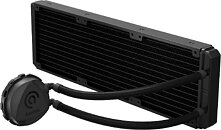
Asetek's Patent for Integrated Pump in AIO Liquid Coolers Expired Today
As some of you may know, Danish company Asetek has had something of a monopoly in the all-in-one liquid cooling market and this was large due to a single patent that expired today. The patent in question PCT/DK2005/000310 or US8240362 has been used by the company to force many of its competitors either out of business, or cost them a small fortune as they tried to circumvent it. This is why so many companies have licensed AIO liquid cooler designs from Asetek and why there hasn't been a ton of innovation in the market until the past couple of years, when we've finally seen some innovative solutions that work around the patent.
By now, this is a 20 year old patent that was filed by Asetek founder André Sloth Eriksen on this day in 2005. What this means for Asetek at this point in time is unclear, but with the company no longer being able to sue its competitors for producing AIO coolers with the pump integrated into the waterblock, it seems like they no longer have an edge over their competitors. That said, it's unlikely we'll see a dozen new competitors cropping up, as the liquid cooling market is already quite competitive and hardly the most profitable business to be in. With that said, Asetek did mention in their last quarterly report which was released in April, that they've been approached by a company that is interested in taking over their liquid cooling business, so we might see Asetek divesting from liquid cooling in the future.
By now, this is a 20 year old patent that was filed by Asetek founder André Sloth Eriksen on this day in 2005. What this means for Asetek at this point in time is unclear, but with the company no longer being able to sue its competitors for producing AIO coolers with the pump integrated into the waterblock, it seems like they no longer have an edge over their competitors. That said, it's unlikely we'll see a dozen new competitors cropping up, as the liquid cooling market is already quite competitive and hardly the most profitable business to be in. With that said, Asetek did mention in their last quarterly report which was released in April, that they've been approached by a company that is interested in taking over their liquid cooling business, so we might see Asetek divesting from liquid cooling in the future.


















































